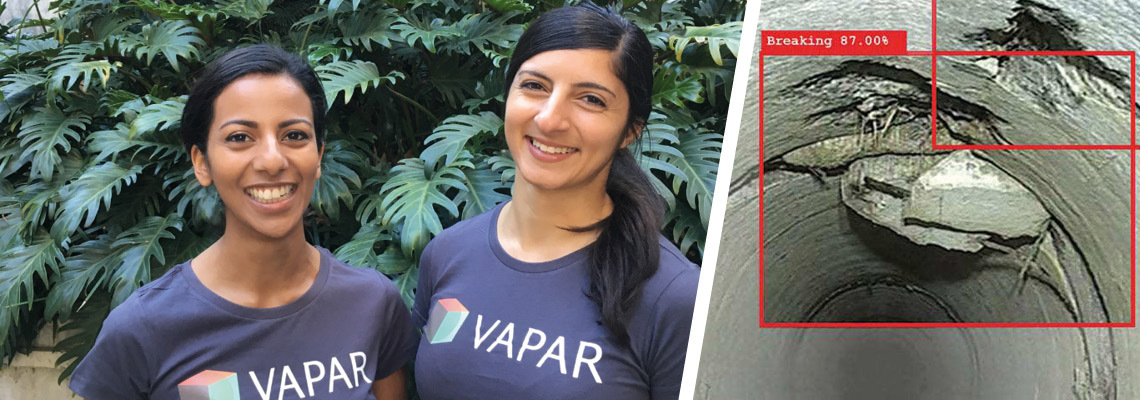Aussie sewer duo see a pipeline of growth to automate CCTV inspection
Australian start-up, VAPAR, is on a mission to help automate and speed up fault detection in sewer pipe infrastructure. We speak to the co-founders to find out more.
An opportunity to digitalise
Australian AI-based engineering start-up VAPAR is on a mission to revolutionise how sewer CCTV footage is analysed for inspections and repair.
The two co-founders, Amanda Siqueira and Michelle Aguilar have raised AUD 1.2 million and are working on projects in Australia, New Zealand, and the UK.
Network infrastructure condition assessments and inspections are fundamental for water utilities to identify where to focus their rehabilitation efforts.
Traditional methods involve CCTV cameras on devices known as “crawlers” introduced to sewer and stormwater pipes to check for damage, with footage often reviewed multiple times manually.
After working in the inspection team as an intern for utility Sydney Water, Siqueira said she saw an opportunity to digitalise what she refers to as a “very manual, slow and repetitive task” for utilities.
“CCTV footage is reviewed onsite, and then it's reviewed in the office, and then it's reviewed again before it gets repaired,” the CEO recalled. “Each piece of footage, every metre is watched at least twice, if not three times.”
“With over six million kilometres of sewer pipe worldwide, it’s a huge market.”
Speaking to Aquatech Online, Siqueira said: “It's this absurd triple handling that goes on, introducing error into every layer, and there’s more subjectivity introduced with every person involved.”
The CEO believes with “over six million kilometres of sewer and drainage pipe worldwide, it’s a huge market, especially with very few of those kilometres of pipes having ever been inspected”.
Partnerships and trials
Standing for Video Analytics Processing And Reporting, VAPAR was founded in 2018. The system works by using an algorithm to auto-code CCTV videos using artificial intelligence.
A partnership trial with Veolia Network Services in Victoria previously assessed the technology based on 198 videos, representing 3.6 km of pipes selected from various inspection campaigns.
Early results showed that the VAPAR algorithm performed “relatively well”, missing only 13 per cent of sewer defects from the CCTV footage, compared to 37 per cent of a manual operator. This was attributed to the “micro-defects” spotted by the algorithm, which can often be overseen by operators.
Siqueira recently spoke at the World Water Tech Innovation Summit virtual event. Alongside fellow start-up, Julius, the VAPAR CEO had the chance to quiz utility innovation managers, including Jan Gooijer from Vitens in the Netherlands.
In the UK, VAPAR also secured a place in the second cohort of the United Utilities Innovation Lab programme.
The organisations have been working together to use United Utilities historical data to help refine and test the AI models. One aim is to improve the speed taken to identify defects that might have gone unnoticed and understand new situations and applications.
Automation is not a replacement tool
Michelle Aguilar, CTO and Co-founder of VAPAR, believes digitalising sewer CCTV inspections can reposition, not replace, skilled operators.
“For tasks to be automated, they have to be repeatable and in high volume,” she said. “The type of processes that become automated are tasks that skilled people shouldn't have to be doing. For example, data entry or similar roles.
“Automation is not a tool to replace people. It allows people to make better decisions with higher volumes of decentralised data."
“Automation is not a tool to replace people. It's simply another tool that allows people to go forth and make better decisions with higher volumes of centralised data.”
As well as Australia, New Zealand and the UK, the founders have their sights set on the US market in the future.
“The Australian standards and the UK standards are very much geared to quantifying things to a granular level of detail, versus the New Zealand standard, which is more built for repeatability,” adds Siqueira.
“The technology is designed to be accurate, standardised and fast, so we are aligning to these markets first. The UK is a great market because just by being small and agile, they're very innovative, quick to adopt and test. And so getting that feedback for a company our size is crucial.”
Related content
- Meet Asim, Nidhi and their sewer scanning robots
- Angela MacOscar: Leading the innovation dance of utility culture change
- Fatberg detecting 5G sewer nervous system goes down under
Share your water technology stories with us
Do you have an innovation, research results or an other interesting topic you would like to share with the international water technology industry? The Aquatech website and social media channels are a great platform to showcase your stories!
Please contact our Sr Brand Marketing Manager Annelie Koomen.
Are you an Aquatech exhibitor?
Make sure you add your latest press releases to your Company Profile in the Exhibitor Portal for free exposure.
We promise never to send you spam and you can unsubscribe at any time!
